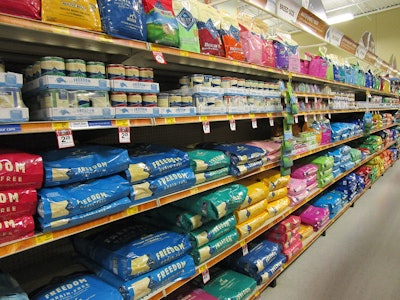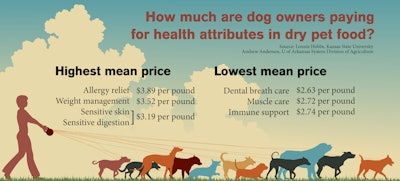
As pet owners increasingly treat their animals like family, a new academic study sheds light on how much they’re willing to pay for dog food with specific health and wellness claims.
The study, published in the Journal of Agricultural and Applied Economics, examined 1,268 dry dog food products listed on Chewy.com to determine which health-focused attributes drive up price — and which don’t. The results offer insights for pet food manufacturers developing new products, as well as consumers making purchasing decisions.
The study noted trends like premiumization and humanization have made pet owners more aware of the health and safety of their pets’ food in an attempt to keep their pets healthy and happy.
“Pets have gone from being in the doghouse to being a member of the family, so when it comes to the diet of the pet, that’s a big way in which that bond manifests,” said Andrew Anderson, co-author of the study and assistant professor of agricultural economics at the University of Arkansas and the Arkansas Agricultural Experiment Station.
Amid these trends, the pet food industry grew from $65.9 billion in 2012 to $123.6 billion in 2022, the study said, quoting figures from Statista. The U.S. pet food market is the largest global pet food market and contributor to the global sales total, generating $53.04 billion in revenue in 2022.
In response, the pet food industry is supplying foods that have claims that sound a lot like what we see in specialty foods for humans, he added.
Premium prices for certain claims
Anderson and co-author Dr. Lonnie Hobbs Jr., assistant professor at Kansas State University, analyzed dry dog food because of its dominant global market share. Using a pricing model that excluded brand names to avoid bias, the researchers examined 60 brands of dry dog food to determine how specific health claims influenced price. They chose dry food because it has the highest market share among all other pet food markets globally.

The highest average prices per pound were for products labeled with claims like “allergy relief” ($3.89), “weight management” ($3.52), “sensitive skin” and “sensitive digestion” (both $3.19). Allergy relief products—despite making up just 2% of the data set — commanded a 17% premium, which Anderson said could be due to added ingredients like antihistamines.
By contrast, products labeled for “dental breath care” ($2.63), “muscle care” ($2.72), and “immune support” ($2.74) had the lowest average prices per pound.
“The sensitive digestion attribute, for example, is in 24% of the products but it also commands a 3.7% premium,” Anderson said. “When you think about demand, that’s kind of a proxy for that high quantity and price, so to me that sounds a lot like a demand-driven attribute, whereas allergy relief is only in 2% of the products, and it commands a very large 17% premium. So, it’s not definitive, but it is likely more of a supply side factor in that case.”
When you see a high quantity and high price, as opposed to a low quantity and high price, you start thinking “demand,” Anderson explained.
Health concerns shaping buyer behavior
In the pet food market, health and wellness products are becoming increasingly important in shaping customer purchasing behaviors. Anderson and Hobbs pointed to recent studies in the U.S. and the UK showing dogs are overweight or have at least one health disorder including dental, skin or intestinal issues.
Citing the Association for Pet Obesity Prevention’s 2022 study, 59% of dogs in the U.S. were classified as overweight or obese. It was a 3% jump from 2018. The UK study took a random sample of more than 22,000 dogs from 784 veterinary clinics and found that nearly 66 percent of dogs had at least one health disorder.
Strategic implications for brands and buyers
For a marketer, Hobbs said the results could be used to see how frequently a health attribute is included, and what its price point is, to gauge the product’s demand. Manufacturers might also evaluate product development strategies that combine multiple premium-associated attributes, Hobbs said. For instance, the significant premiums associated with both “allergy relief” and “sensitive digestion” suggest potential opportunities in specialized formulations addressing multiple health concerns.
The price discounts associated with certain health claims like “dental care," however, suggest these features may be better positioned as complementary attributes rather than primary product attributes, Anderson added.
The findings may benefit pet food buyers as well, Anderson said, by offering detailed information on pricing and health attributes. For example, while “allergy relief” products command higher prices, pet food buyers can evaluate whether these specialized formulations address their pet’s specific needs. Conversely, products with “dental care” features may offer high-value opportunities despite being only marketed as such.
Using filters available with online shopping platforms, Hobbs said pet food buyers can make faster comparisons between products by identifying which product attributes they want at the price point desired and read customer reviews.
Information authored by John Lovett, University of Arkansas System Division of Agriculture, Arkansas Agricultural Experiment Station.
















